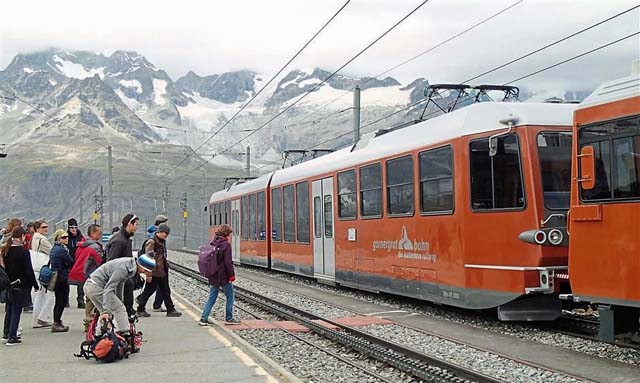
in Switzerland
Zermatt Switzerland - The easiest way to "climb" mighty mountains in Switzerland is to cheat a little.
I was in a part of the country called Valais, home to the densest concentration of snowy peaks in the Alps.
It has a whopping 45 "four-thousanders", peaks of over 4,000 metres in altitude, including the most famous one, Matterhorn.
After arriving in the pretty resort town of Zermatt in the afternoon, I couldn't wait to get to the mountains.
A five-minute walk from my hotel brought me to the train station of Gornergrat Bahn.
This is Europe's highest open-air cog railway which climbs almost up to Gornergrat peak (3,135 metres).
I hopped onto the train and soon after departure, the raw, triangular mass, of the magnificent Matterhorn (4,478 metres) sprang into view.
My camera was busy, I didn't care if I looked like some idiot tourist who had never seen a snow mountain before.
Along the way, there were dramatic bridges and tunnels, forests of larch and pine, rocky ravines, lush valleys, and mountain lakes.
They talk of typical Swiss clockwork efficiency, and sure enough, my train departed and arrived at 14:24 and 14:57 respectively, not a minute earlier or later.
This is what I mean by "cheating" at mountain climbing, all of the vistas, none of the sweat.
At the top station, I heard strains of Bollywood music, a film crew was shooting a movie scene.
I walked about and feasted my eyes on a gleaming river of ice, the second-largest glacier in the Alps, the Gorner Glacier.
All this was fine and dandy but as a hiker, I still needed to actually trek.
Since I wasn't equipped with snow shoes or ice picks, I took the train down to the next station, Rotenboden, which was below the snow line.
From here, it was a gentle 10 minute downhill walk to Riffelsee lake, famous for its brilliant views of Matterhorn reflected on its mirror surface.
But alas, by this time, the clouds had rolled in, obscuring the peak.
Nevertheless, the sheer majesty of the setting, coupled with the brisk air, was invigorating.
Hiking is one of the most popular activities in Valais.
With over 400 kilometres of marked trails, every hiker can find a trail to suit him or her, whether to the top of a mountains, or like me, using a combination of trains and legs for more relaxing walks.
After a half-hour walk, I took the train down again to Riffelberg to check out the 2 kilometre trail there.
There I saw Biscuit, a huge slobbering, bumbling St Bernard, complete with a small barrel round the neck.
Its owner brings it up here to pose with tourists for a small fee.
As I boarded the train down, the mournful-looking fella delighted other passengers when they saw him sprawled on the floor like a living rug.
Mountain Foods
At dinner that night, there was a performance of traditional long Swiss wooden trumpets, called Alphorns.
The moody melodies made me think of another mountain people who also use such long trumpets, the Tibetans.
Valais cuisine features the best produce of the mountains.
I started with Fendant, a crisp local white wine.
With its 5,000 hectares of vineyards and 60 grape varieties, planted on steep south-facing hillsides that make the most of the sunshine, Valais is a centre of Switzerland's wine industry.
You can also hike through the vineyards on the 50 kilometre Valais Wine Trail that takes you through centuries-old irrigation canals and yes, 180 wine cellars where Valais wines can be tasted.
But try not to tumble down the mountain after!
Anyone hiking in this country will notice the many cows grazing in pristine mountain pastures, I'd like to imagine that happy cows are the reason why Alpine milk is so renowned.
And when the milk is good, so are the chocolates.
And the cheeses.
One classic Valais dish is raclette, which is cheese melted onto a plate.
Its creaminess and distinctive flavour goes well with hams, sausages, potatoes, gherkins, small onions, and wine.
Raclette is also served with the famous Valais rye bread, which has a grey-brown cracked crust and a slightly acidic aroma, thanks to the high-altitude grain, mineral-rich soil, and extreme temperatures.
And for dessert, you have to try the local apricots, with their soft, sweet flesh, blended with cream.
Gourmet Trekking
The next day, I took a combination funicular train and cable car from Zermatt all the way up to the Rothorn (3,103 metres), a showcase for the highest peaks of the Valais Alps.
In winter, this is a gateway to various ski slopes, in summer it's a popular starting point for various vigorous hikes.
But today's affair would be something different, I had signed up for a gourmet trek.
The idea was to have our appetiser, walk it off for 20 minutes, have a main dish somewhere else, work it off again, do dessert in a third restaurant, and then trek downhill (about an hour) all the way back to Zermatt.
What a great way to enable us to eat more.
Zermatt town is full of fancy restaurants, but it was amazing to find good food up in the mountains too.
Our first stop from the Rothorn cable car station was Paradies restaurant, where we had a delightfully zingy salad.
Then we sauntered to Chez Vrony, a popular place in Findeln village specialising in Mediterranean food (we had a scrumptious roast chicken in wine sauce).
It was a pity that it was cloudy and drizzling, otherwise the full glory of the mountains would have opened up during our hike (or when sitting outdoors at the restaurants).
Nevertheless, this made me appreciate stuff that was closer at hand, the traditional timber houses with rough slate roofs and colourful wild flowers all along the trail.
And even edelweiss flowers, planted at our next stop, Franz & Heidi, where we tucked into luscious chocolate cake.
Ah... what a perfect way to end my trip to Valais.
Rita Chew.



